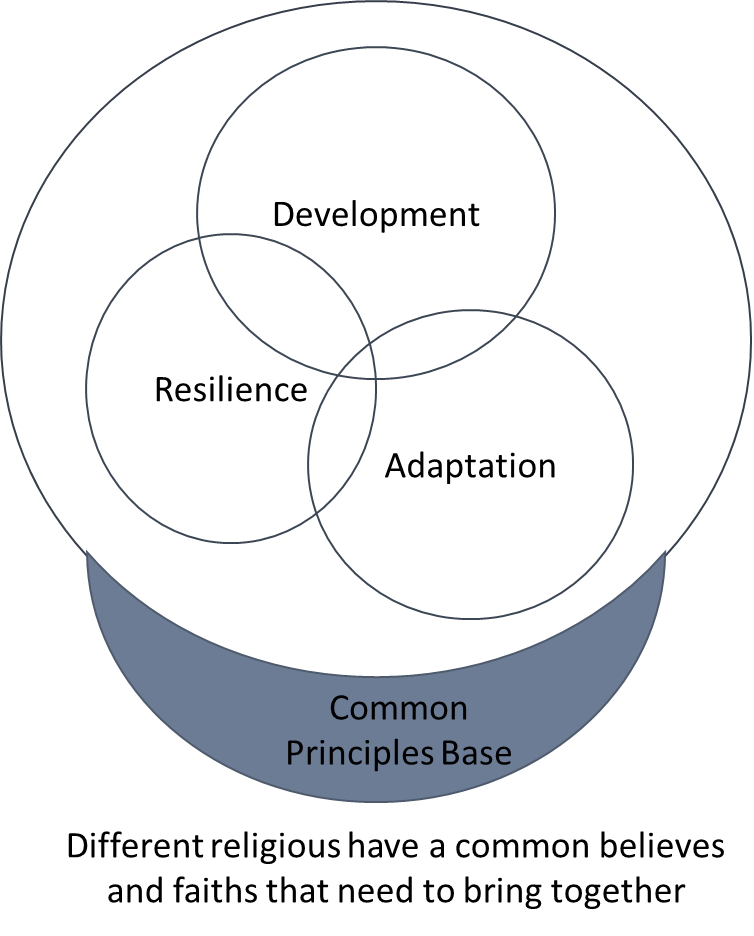Last updated on
The world has got enough to ruin one’s life by religious hatred, communal riots, natural calamities, global warming, or pandemics such as COVID-19. In this challenging time, the life and thought of Swami Vivekananda can act as a rescuer to the world, especially the youths of India. His work encompasses all that is required to live a ‘characterful’ life. From his immense work, I have specifically focused on the idea of ‘unity in religion’ that is very relevant for the youths in modern times. In contemporary times, when people hate each other because of their religious differences, the ‘unity in religion’ even becomes more pertinent to understand. As Swamiji also mentions, “One religion cannot suit all.” By using the ideals of ‘unity in religion’, I bring on how youths of India can leverage this opportunity to establish religious harmony and fight climate change.
In his lecture on ‘the future of India’1, Swami Vivekananda underscores how religious ideas can form the base of unity in nations of Asia. Swami Ji claims that ‘unity in religion’ is essential as the first condition of the future of India. By unity in religion, he means the ‘life-giving common principles’ of religions, which can base all religious faiths. He also claims that nothing is higher than religious ideals in India, and unifying the power of religion, i.e., the common principles can keep the nation in unity. This idea also resonates with India’s cultural landscape that focuses on eco-centrism. Here is a shloka from the Gita where Krishna says,
“भमिू रापोऽनलो वायुः खं नो बुदमि् रेव च।
अहङ्कार इतीयं ेभिन्ना प्रकृतिरष्टा।।”
Translation: Earth, water, fire, air and ether and mind, intellect and ego – this is my nature divided in eight ways.
Here, Krishna doesn’t differentiate between ‘nature’, ‘mind’, ‘intellect’, and ‘ego’ so it is eco-centric rather than anthropocentric or ego-centric. This implies that Indian culture has the ability to unite the nations as well as humans to nature.
By accentuating the common principles, I believe we can eliminate all the quarrels and disappointments among and within nations. This idea of the unified power of religion can be used to develop a framework that focuses on the upliftment of everyone. What stands out in the framework is that it goes beyond the political boundaries of the nations and can teach the feeling of togetherness. Essentially, the world dreadfully needs this ‘feeling of togetherness’ to cope with global issues such as global warming, poverty, refuge crisis, water scarcity, and environmental issues. Hence, the youths need to understand the basics of religion and use their religious texts for the unification of nations. While getting into religion, we must also not forget what Swami Ji cautions about us, “Religion is not in books, nor in theories, nor in dogmas, nor in talking, not even in reasoning. It is being and becoming”. In the next section, I stipulate how the ‘unity in religion’, the initial condition for the ‘feeling of togetherness, can help us tackle climate change on a global scale.
At the global level, having a consensus around climate change is a foremost issue. From the failure of the Clean Development Mechanism by 2008 to the Paris agreement in 2015 to the recently concluded COP 26 at Glasgow in 2021, it is evident that the countries around the world have not reached a general agreement to deal with climate change. Moreover, the root of the ongoing climate and ecological crisis lay in the degradation of human values. The unsatisfactory attitude of humans and never-ending human greed result in over-consumption and wastage of scarce resources, exacerbating the ongoing crisis. As Mahatma Gandhi also puts it, “The world has enough for everyone’s needs, but not everyone’s greed“. Hence, to resolve the existing conflicts over climate change, we need to revive our values and firstly work to rejuvenate the feeling of togetherness. I believe that if we as the citizens of earth have faith in the ‘unity in religion’, it will be easier to come together for the existence of the human race on the planet.
For a nation like India, a land of religions, only political ideas and thoughts cannot contain diversity. As Gandhi Ji also argues, there can be “no politics without religion” in India. Hence, the unity in religion formulates the base of India’s politics. Hence, the unity in religion emerges as the last bestow for solving overarching issues such as climate change. Climate Change is a term used to define the long-term shift in weather patterns and temperature. It can be reinforced by anthropogenic activities such as burning fossil fuels and natural causes such as volcanic eruptions. Extreme weather conditions such as intense droughts, short durational intense rainfall, flooding, melting of glaciers, water scarcity, rising seas, loss of biodiversity, and many more are repercussions of climate change. These cascading impacts of climate change have its consequence on the livelihoods and lives of all. The solution to climate change encompasses some hefty words such as adaptation, mitigation, and resilience (refer to figure 1, it depicts how the common principles can act as the foundation for mitigating climate change). For general reference, adaption is defined as adjustments that need to be made in response to expected or unexpected climatic effects with time. And mitigation refers to the efforts put in for reducing or preventing greenhouse gases (namely, Carbon dioxide, methane, and oxides of nitrogen)—adaptation and mitigation help from developing resilience that denotes the ability to respond and prepare against climate change.

Figure 1: The common principles of religion (unity in religion) can act as the foundation for mitigating climate change).
For climate-resilient development, India needs to use the religious unity-pushed development in synergy with adaptation, mitigation, and resilience. No doubt, Mitigation, and adaptation have time frame problems. Mitigation is a long-term game; hence, adaptation-based development should be synergized with the mitigation (refer to figure 2). It represents three possible pathways for climate change; we need to choose the middle one, which shows that the efforts that lead to mitigation need to be made. Here, the unity in religion will direct us what actions need to be taken for coping with climate change with an approach that ‘no one leaves behind’. These actions may include policy-level interventions to on-ground work.

Figure 2: The possible pathways for climate change actions.
Here, I am not arguing that unity in religion is the answer to all the challenges of climate change. Rather I want to underscore that this idea can help us to come to the same ground with a common vision by accommodating the differences and dissents. In long term, this can also help us to eliminate poverty and inequality (caste, race, sex, creed, and religion) and to promote justice and social mobility. In a nutshell, it will help us to achieve the ambitious Sustainable Development Goals and mainstream climate action.
As the youth of India, we owe a responsibility to secure the future of India and the World. We are the ambassador for establishing unity in religion. Always remember, “Arise, awake, and stop not till the goal is reached “.
1 THE FUTURE OF INDIA – Swami Vivekananda | Arise Bharat. (2022). Retrieved January 3, 2022, from
Share your feedback directly with the author. Email: ritika@scimonk.com .
Stay updated.



